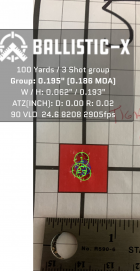The Berger site twist calculate says the 90 is marginally stable with a 7 twist. YMMV
Unfortunately, the language used in the output of the Berger Twist Rate Calculator can be somewhat...misleading. Here is the output for a 7-twist barrel for
pointed 90 VLDs (estimated G7 BC = 0.290) using a muzzle velocity of 2825 fps, which is not unreasonable for a 30" barrel, an elevation of 1000 ft., and 70 degrees F temperature (i.e. a rather average set of environmental conditions):

Note that the predicted decrease in G7 BC is only 1% (i.e. a G7 BC of 0.290 for
pointed 90 VLDs would be compromised by 1%, resulting in an
effective G7 BC of 0.287). No one is going to even notice a decrease in BC of 1%, as the inherent BC variance within a single Lot# of bullets is greater than 1%. The decrease in G7 BC would be slightly greater at a lower elevation and/or temperature, or at a slower muzzle velocity. Nonetheless, the BC of the 90 VLD from a 7-twist barrel would still be approximately 20% greater than that of a
pointed 80.5 Fullbore bullet. In terms of wind deflection, a 20% increase in BC is HUGE.
There is nothing at all wrong with the 80.5 Fullbore bullet. In fact, it is an outstanding design. But for F-TR shooters using a .223 Rem that are already at a sizeable disadvantage against shooters using .308 Win rifles, the 85.5s/88s/90/95s are much better choices. As has been noted, an appropriate [long] freebore is necessary for the 85.5 to 95 gr bullets to obtain optimal performance. One could also use a slightly faster twist rate such as a 6.8- or 6.7-twist to obtain the full intrinsic BC, but a 7.0-twist will do the job and will generally cause a slightly lesser risk for jacket failure that a faster twist rate.
A few years ago, Bryan Litz advocated using a twist rate that would maintain a minimum gyroscopic coefficient (Sg) of 1.4 for a given bullet in order to obtain its full intrinsic BC. He later changed that to an Sg of 1.5 to get the full BC. I believe the manner in which the Berger Twist Rate Calculator designates Sgs between 1.0 and 1.5 as being "Marginal" can be misleading. In my hands, an Sg above 1.20-1.25 will result in gyroscopic stability as far as preventing obvious unstable bullet behavior such as oblong holes in the target, or even keyholing. In other words, the gyroscopic stability with an Sg greater than 1.20-1.25 in terms of obvious readouts such as oblong holes in the target or even keyholing is not "Marginal", but rather is just fine. It is true that a bullet fired from a slow twist rate barrel may behave as though its BC is lower than it actually is, but that is an effect that would largely manifest in terms of wind deflection and thus be much more difficult to readily observe than oblong holes in a target. For example, running bullets in a barrel twist rate that yields an Sg of ~1.3 will fly just fine to the target (i.e. they will be "stable", but they may be deflected a bit farther off line than might be expected based on the muzzle velocity and the manufacturer's BC value. Thus, "Marginal" is not a word I would choose for bullets having an Sg of perhaps 1.3 to 1.5. Sub-optimal, yes, but not "Marginal".















